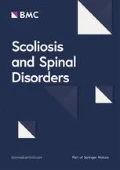Objectives
The objectives of this study were to measure patients' brace compliance; to assess in-brace correction at initial treatment period; to assess quality of life (QoL) of patients with AIS; and to estimate the correlation among patients' brace compliance, in-brace correction and QoL of patients with AIS.
Material and method
In this prospective correlation study, 55 patients diagnosed with AIS were recruited. All were female and aged 10 years or above when a brace was prescribed, none had undergone prior treatment, and all had a Risser sign of 0-2 and a Cobb angle of 25-40 degree. The patients were examined in 3 consecutive visits with 4-6 months between each visit. The Chinese translated Trunk Appearance Perception Scale (TAPS) (Range 1-5), the Chinese translated Brace Questionnaires (BrQ) (Range 20-100) and the Chinese translated SRS-22 Questionnaires (Range 22-110) were used. In-brace Cobb angle, vertebral rotation and trunk listing were measured. Patients' compliance, in-brace correction and patients' QoL were assessed. To identify the relationship among these three areas, logistic regression model and generalized linear model were used.
Results
For the compliance measure, a significant difference (p = 0.008) was detected on the TAPS mean score difference between Visits 1 and 2 in the least compliant group (0-8 hours) and the most compliant group (17-23 hours). It was predicted that the TAPS mean score difference of group 1 (0-8 hours) was 0.70 less than that of group 3 (17-23 hours). In addition, a significant difference (p = 0.000) was detected on the BrQ mean score difference between Visits 2 and 3 in the least compliant group (0-8 hours) and the most compliant group (17-23 hours). It was estimated that the BrQ mean score difference of group 1 (0-8 hours) was 16.28 less than that of group 3 (17-23 hours). For the orthosis effectiveness measure, no significant difference was detected between the 3 groups of bracing hours (0-8 hours, 9-16 hours, 17-23 hours) on in-brace correction (below 40% and 40% or above). For the QoL measure, no significant difference was detected between the two different in-brace correction groups (below 40% and 40% or above) on QoL as refected by the TAPS, BrQ and SRS-22r mean scores.
Conclusion
This study showed a positive and significant relationship between patients' brace compliance and patients' QoL. Neither significant relationship was found between patients' brace compliance and in-brace correction nor between in-brace correction and patients' QoL.
Author information
Authors and Affiliations
Rights and permissions
This article is published under an open access license. Please check the 'Copyright Information' section either on this page or in the PDF for details of this license and what re-use is permitted. If your intended use exceeds what is permitted by the license or if you are unable to locate the licence and re-use information, please contact the Rights and Permissions team.
About this article
Cite this article
Chan, S.L., Cheung, K., Luk, K. et al. A correlation study between brace compliance, in-brace correction and quality of life (QoL) of patients with Adolescent Idiopathic Scoliosis (AIS). Scoliosis 10 (Suppl 1), O77 (2015). https://doi.org/10.1186/1748-7161-10-S1-O77
Published:
DOI: https://doi.org/10.1186/1748-7161-10-S1-O77

